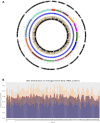Pervasive sequence-level variation in the transcriptome of Plasmodium falciparum
- PMID: 35591889
- PMCID: PMC9112769
- DOI: 10.1093/nargab/lqac036
Pervasive sequence-level variation in the transcriptome of Plasmodium falciparum
Abstract
Single-nucleotide variations (SNVs) in RNA, arising from co- and post-transcriptional phenomena including transcription errors and RNA-editing, are well studied in a range of organisms. In the malaria parasite Plasmodium falciparum, stage-specific and non-specific gene-expression variations accompany the parasite's array of developmental and morphological phenotypes over the course of its complex life cycle. However, the extent, rate and effect of sequence-level variation in the parasite's transcriptome are unknown. Here, we report the presence of pervasive, non-specific SNVs in the P. falciparum transcriptome. SNV rates for a gene were correlated to gene length (r[Formula: see text]0.65-0.7) but not to the AT-content of that gene. Global SNV rates for the P. falciparum lines we used, and for publicly available P. vivax and P. falciparum clinical isolate datasets, were of the order of 10-3 per base, ∼10× higher than rates we calculated for bacterial datasets. These variations may reflect an intrinsic transcriptional error rate in the parasite, and RNA editing may be responsible for a subset of them. This seemingly characteristic property of the parasite may have implications for clinical outcomes and the basic biology and evolution of P. falciparum and parasite biology more broadly. We anticipate that our study will prompt further investigations into the exact sources, consequences and possible adaptive roles of these SNVs.
© The Author(s) 2022. Published by Oxford University Press on behalf of NAR Genomics and Bioinformatics.
Figures




Similar articles
-
The RNA structurome in the asexual blood stages of malaria pathogen plasmodium falciparum.RNA Biol. 2021 Dec;18(12):2480-2497. doi: 10.1080/15476286.2021.1926747. Epub 2021 Jun 23. RNA Biol. 2021. PMID: 33960872 Free PMC article.
-
Impact of Sickle Cell Trait Hemoglobin on the Intraerythrocytic Transcriptional Program of Plasmodium falciparum.mSphere. 2021 Oct 27;6(5):e0075521. doi: 10.1128/mSphere.00755-21. Epub 2021 Oct 20. mSphere. 2021. PMID: 34668757 Free PMC article.
-
Dispensable Role of Mitochondrial Fission Protein 1 (Fis1) in the Erythrocytic Development of Plasmodium falciparum.mSphere. 2020 Sep 23;5(5):e00579-20. doi: 10.1128/mSphere.00579-20. mSphere. 2020. PMID: 32968006 Free PMC article.
-
Epidemiology, drug resistance, and pathophysiology of Plasmodium vivax malaria.J Vector Borne Dis. 2018 Jan-Mar;55(1):1-8. doi: 10.4103/0972-9062.234620. J Vector Borne Dis. 2018. PMID: 29916441 Free PMC article. Review.
-
Chromatin-mediated epigenetic regulation in the malaria parasite Plasmodium falciparum.Eukaryot Cell. 2010 Aug;9(8):1138-49. doi: 10.1128/EC.00036-10. Epub 2010 May 7. Eukaryot Cell. 2010. PMID: 20453074 Free PMC article. Review.
Cited by
-
Detection of Developmental Asexual Stage-Specific RNA Editing Events in Plasmodium falciparum 3D7 Malaria Parasite.Microorganisms. 2024 Jan 10;12(1):137. doi: 10.3390/microorganisms12010137. Microorganisms. 2024. PMID: 38257964 Free PMC article.
References
-
- World Malaria Report 2020; https://www.who.int/teams/global-malaria-programme/reports/world-malaria....
-
- Tarr S.J., Díaz-Ingelmo O., Stewart L.B., Hocking S.E., Murray L., Duffy C.W., Otto T.D., Chappell L., Rayner J.C., Awandare G.A.et al. .. Schizont transcriptome variation among clinical isolates and laboratory-adapted clones of the malaria parasite plasmodium falciparum. BMC Genomics. 2018; 19:894. - PMC - PubMed
LinkOut - more resources
Full Text Sources
Molecular Biology Databases

